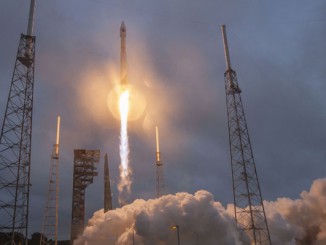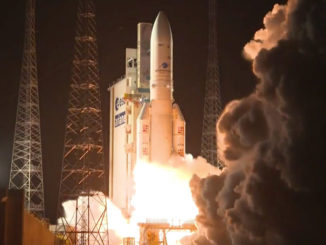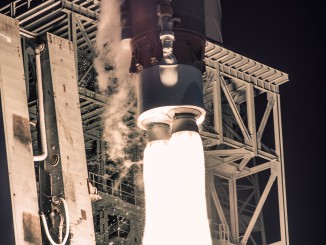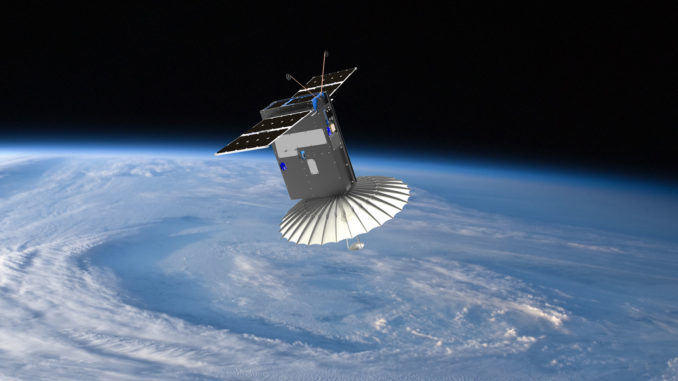
Fifteen CubeSats owned by NASA, Spire Global, and U.S. research institutions launched aboard a Northrop Grumman Cygnus cargo ship in May have been released into orbit, beginning missions to demonstrate miniaturized, low-cost Earth science instruments and join a commercial network of weather-monitoring nanosatellites.
Nine of the satellites were released July 13 from a NanoRacks deployer outside the International Space Station, and six more sprung out of a NanoRacks carrier module mounted to the exterior of the Cygnus supply ship July 15, hours after the automated freighter departed the station.
The nine CubeSats released from the space station were delivered inside the Cygnus spacecraft’s pressurized cargo module May 24, three days after launching from Wallops Island, Virginia. Astronauts transferred the nanosatellites, which ranged in size from a Rubik’s Cube to a briefcase, inside a separation mechanism through an airlock in the station’s Kibo lab module, where a robotic arm picked up the deployer to release the CubeSats.
Seven of the CubeSats came from NASA and other U.S. universities, and two were developed by start-up companies.
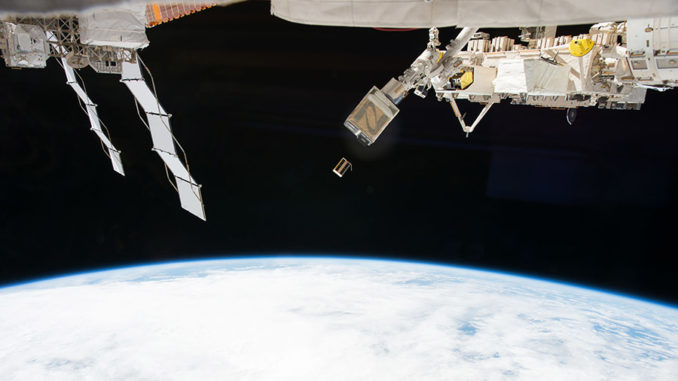
One of the CubeSats, named RainCube, carries a miniaturized radar developed by NASA’s Jet Propulsion Laboratory. The Ka-band radar, designed to measure rainfall and other precipitation on Earth, is the first such instrument to fit inside a CubeSat, according to Eva Peral, RainCube’s principal investigator at JPL.
“CubeSats have been around for a long time, so what is the challenge about putting a radar in a CubeSat? Radars are notorious for being very large, very power-hungry instruments,” Peral said before RainCube’s launch May 21. “A group of JPL engineers developed a new architecture for radars, and we were able to reduce the size, mass and power consumption of the radar by about an order of magnitude, about a factor of 10.”
RainCube was programmed to deploy a dish-shaped 1.6-foot (50-centimeter) radar antenna after its release from the space station. The roughly 26-pound (12-kilogram) spacecraft is designed for a two-month primary mission to test out the radar.
Peral said NASA’s CloudSat satellite, which launched in 2006, carries a similar radar to RainCube. But the instrument aboard CloudSat is around 80 times the volume of the radar on RainCube.
“It’s a significant advancement in technology,” Peral said.
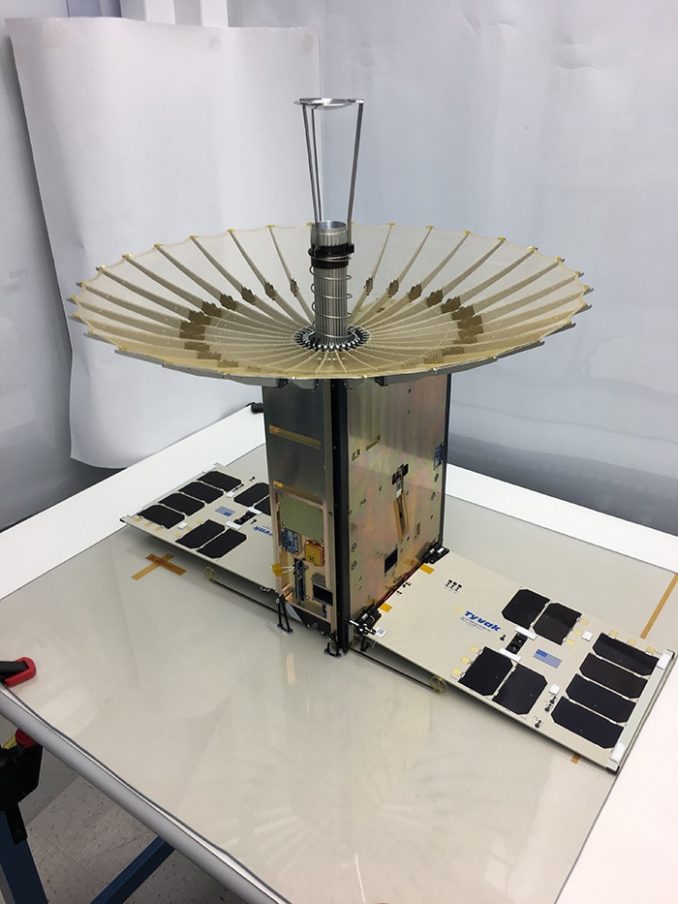
If the radar and antenna function as intended, RainCube could pave the way for future CubeSats to collect global precipitation data with greater frequency and at lower cost than existing satellite missions. The antenna technology also has applications in commercial communications networks.
“With RainCube, we expect that we could send a constellation of these little CubeSats (into orbit), and then we could measure very frequent observations of precipitation,” Peral said.
Another CubeSat, named TEMPEST-D, deployed from the space station July 13 to begin its own technology demonstration mission.
Developed in partnership between JPL, Colorado State University and Blue Canyon Technologies, TEMPEST-D stands for the Temporal Experiment for Storms and Tropical Systems – Demonstration. The briefcase-sized CubeSat hosts a five-channel millimeter-wave radiometer that could be used by a fleet of future nanosatellites to scan developing tropical cyclones help scientists learn how they intensify and change.
“With a train-like constellation of TEMPEST-like CubeSats, we’d be able to take time samples every five to 10 minutes to see how a storm develops,” said Steven Reising, TEMPEST-D’s principal investigator at Colorado State University.
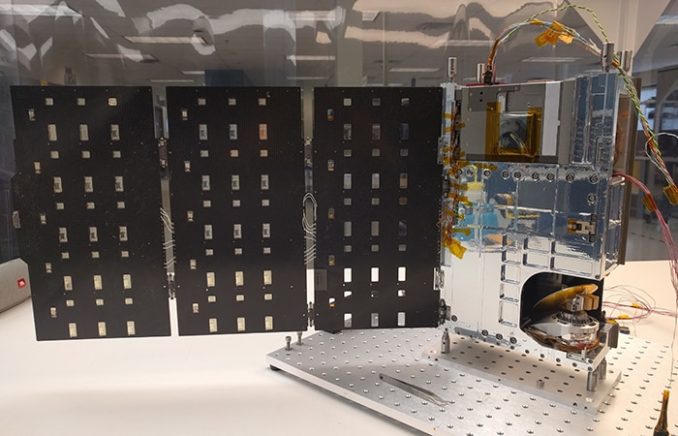
The CubeRRT nanosatellite was also released into orbit July 13 to begin a year-long mission testing a new processor that could help future Earth observation and climate research spacecraft obtain better data.
The processor on the CubeRRT tech demo CubeSat is designed to eliminate the effects of man-made radio emissions that reduce the precision of microwave radiometers on-board larger Earth science satellites.
Radio signals from wireless communications and radar operations on Earth can reach receivers on satellites, masking the planet’s natural microwave emissions in the same frequency bands, which are useful for sensors looking at water vapor in the atmosphere, precipitation, sea surface temperatures and ice coverage, according to Joel Johnson, CubeRRT’s principal investigator at Ohio State University.
“This is a problem for microwave radiometers trying to observe Earth, and as demand for the spectrum keeps getting higher and higher, it’s harder and harder to keep doing these important scientific measurements,” Johnson said.
“CubeRRT is all about a new kind of processor to attach to a microwave radiometer so that it can still continue to measure the natural thermal emissions, even in the presence of other signals that are coming from Earth that are man-made,” Johnson said.
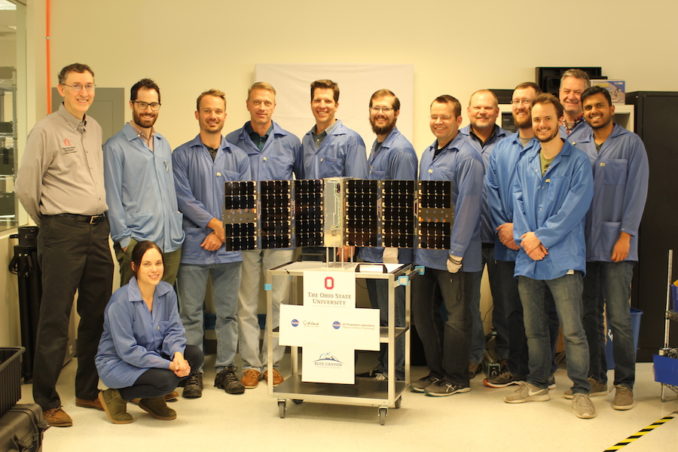
HaloSat was another CubeSat deployed from the space station July 13.
Developed at the University of Iowa in partnership with NASA, HaloSat is designed to detect X-ray gas emissions around the Milky Way galaxy. Scientists hope HaloSat’s measurements will help determine the shape and mass of a halo of hot gas surrounding the galaxy.
The results could help astrophysicists in their search for “missing” matter — material that has escaped detection since the aftermath of the Big Bang produced relic light known as the cosmic microwave background. Since the birth of the universe 13.8 billion years ago, matter has coalesced to form structures such as gas and dust clouds, galaxies, stars and planets.
Cosmologists say the universe contains just 5 percent normal matter — the stuff you can see and touch — while 25 percent of the universe is made up of dark matter, and 70 percent is dark energy, a mysterious force accelerating the universe’s expansion.
But scientists have accounted for only about half of the normal matter that should be in the universe. Researchers believe the undetected matter could be contained in hot gas clouds between galaxies, or in halos surrounding galaxies like our own Milky Way.
HaloSat’s measurements could help scientists determine whether galactic halos of hot gas could harbor the missing matter.
The first privately-developed nanosatellite for Analytical Space, a startup based in Massachusetts, was also deployed from the space station July 13.
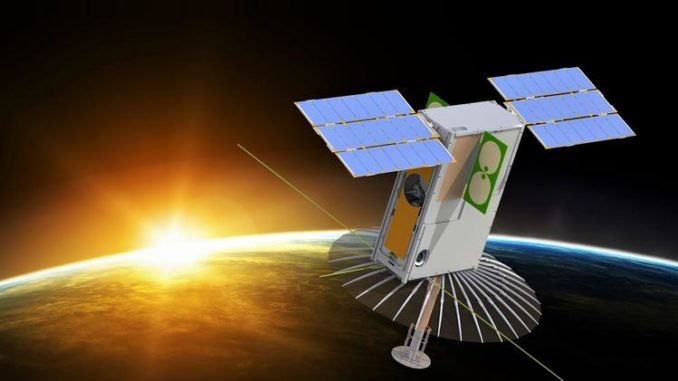
Named Radix, the CubeSat is a proof-of-concept tech demo mission for Analytical Space, which is developing a constellation of nanosatellites that could create a commercial data relay network. The CubeSats proposed by Analytical Space would receive data from other satellites via radio signals, then process the data and transmit it to Earth with a laser transmitter, which can beam information at higher data rates than feasible with conventional radios.
The approach would allow remote sensing craft, orbiting surveillance platforms, and other satellites using existing technology to take advantage of higher-speed laser communications, according to Analytical Space, which is backed by The Engine, a venture capital fund founded by MIT and other private investment firms.
Engineers will use Radix for beta-testing of the data relay concept. Analytical Space says it has lined up partners to use their satellites to communicate in orbit with Radix, which will then downlink the data to Earth through high-speed radio and laser terminals.
Four other CubeSats were released from the space station July 13:
- EQUiSat, a 1U CubeSat developed by Brown University with NASA support as an educational outreach mission, with a secondary objective of demonstrating a new type of battery in space.
- MemSat, a 1U CubeSat developed at Rowan University in partnership with NASA, will test a memristor device that could be flown on future satellites to make them more energy efficient and more resilient to power failures.
- RadSat-g, a 3U CubeSat developed at Montana State University in partnership with NASA, will test a new radiation tolerant computer system.
- EnduroSat One, a 1U CubeSat developed in Bulgaria, carries an amateur radio payload.
Another six nanosats were stowed aboard a deployer outside the Cygnus spacecraft itself, awaiting separation after the supply ship’s departure from the space station July 15.
After the Northrop Grumman cargo ship left the station, it raised its orbit to an altitude of more than 300 miles (480 kilometers), setting the stage for the release of six CubeSats for Spire Global and Aerospace Corp. The six CubeSats, each around the size of a shoebox, deployed in pairs from a NanoRacks carrier module mounted on the Cygnus spacecraft over the course of several hours.
We are excited to announce that all six cubesats have successfully been deployed from our CRS-9 #Cygnus! The spacecraft will remain in orbit for another 2 weeks. #NorthropGrumman pic.twitter.com/5peQqFNRSo
— Northrop Grumman (@northropgrumman) July 17, 2018
The CubeSats included four “Lemur-2” payloads for San Francisco-based Spire Global, which builds and operates a fleet of nanosatellites surveying Earth’s atmosphere and tracking maritime traffic. The Lemur-2s deployed July 15 were Spire’s first satellites to carry aircraft tracking receivers alongside the standard marine surveillance and weather-monitoring payloads.
The Aerospace Corp.’s AeroCube 12A and 12B spacecraft were also released to demonstrate new star-tracker imaging sensors, a variety of nanotechnology payloads, advanced solar cells, and an electric propulsion system on one of the two satellites.
The Cygnus cargo freighter is loaded with trash from the space station, and ground controllers at Northrop Grumman’s operations center in Virginia will command the supply ship to re-enter the atmosphere July 30, when it will burn up over the Pacific Ocean.
With the Cygnus spacecraft’s CubeSat deployments, Houston-based NanoRacks said it has accommodated the release of 223 small satellites in orbit, including 185 from the space station itself.
NanoRacks is developing a dedicated commercial airlock for the space station to support more small satellite deployments, along with other unpressurized experiments outside the research outpost.
Email the author.
Follow Stephen Clark on Twitter: @StephenClark1.

